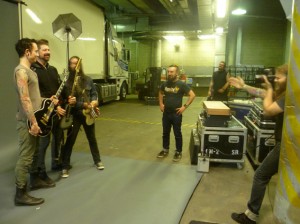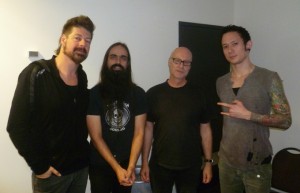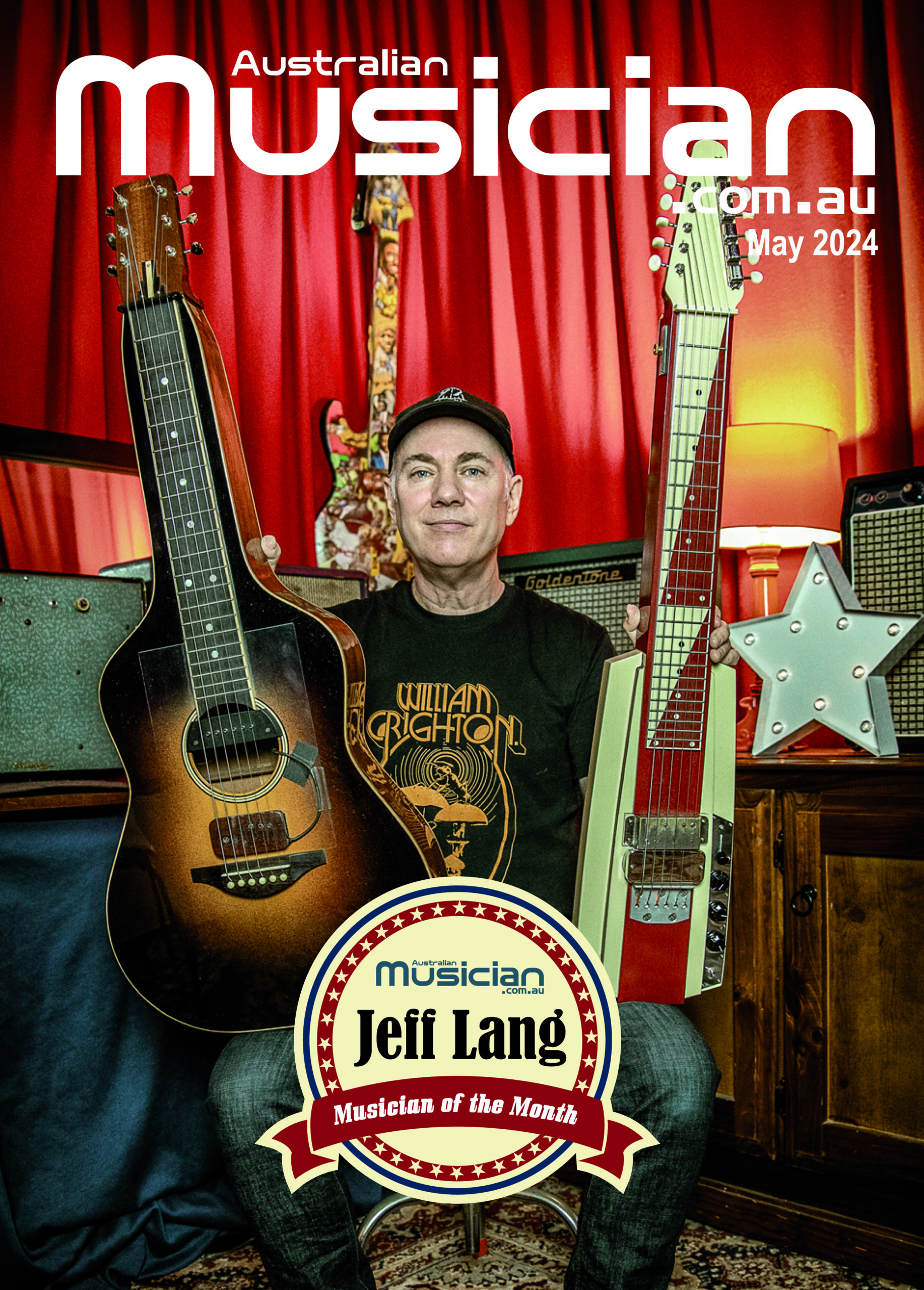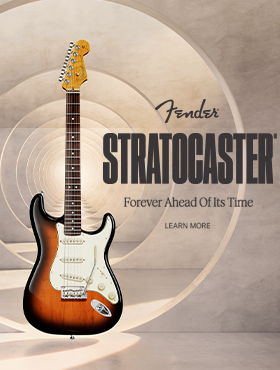March 2012
SLIPNOT’S Jim Root and TRIVIUM’S Matt Heafy interviewed by BUGDUST’S Adam Cole. Pics by Kane Hibberd
 It’s never a good idea scheduling your cover story so close to the print deadline, especially when it consists of juggling guitarists from not one, but two international metal bands on the afternoon of their Soundwave side show soundcheck. We’ve tracked down Slipnot’s Jim Root backstage but he’s keen to find fellow Stone Sour band member Corey Taylor to discuss the 26 tracks they have prepared for the double concept album they are in the middle of creating. Soon after, we’ve located Trivium’s Matt Heafy who is ready to roll with Australian Musician, but Slipnot’s Jim Root is now on stage soundchecking. Matt is content to go through his vocal warm up routine while we wait for Jim, mindful of the fact that Matt soon has a meet and greet commitment and his showtime is just over an hour away. Adam Cole plays guitar and sings in local heavy rock outfit Bugdust. He’s also known in the industry as a skilled luthier who started out at Maton, went on to form Cole Clark guitars with Brad Clark, and for the last 8 years has been calling his own shots, building and fixing guitars (even for the likes of Billy Gibbons no less) and inspiring kids to play from his Lilydale facility. Adam is going to host the three way interview. Martin Connors (Jim’s guitar tech) arrives with Jim’s two Telecasters for the photoshoot, followed by JIm. Shoot done, we find an empty room within the labyrinth that is backstage at Rod Laver Arena. We close the door, shutting out the backstage bustle and we’re left with three talented guys simply talking guitar.
It’s never a good idea scheduling your cover story so close to the print deadline, especially when it consists of juggling guitarists from not one, but two international metal bands on the afternoon of their Soundwave side show soundcheck. We’ve tracked down Slipnot’s Jim Root backstage but he’s keen to find fellow Stone Sour band member Corey Taylor to discuss the 26 tracks they have prepared for the double concept album they are in the middle of creating. Soon after, we’ve located Trivium’s Matt Heafy who is ready to roll with Australian Musician, but Slipnot’s Jim Root is now on stage soundchecking. Matt is content to go through his vocal warm up routine while we wait for Jim, mindful of the fact that Matt soon has a meet and greet commitment and his showtime is just over an hour away. Adam Cole plays guitar and sings in local heavy rock outfit Bugdust. He’s also known in the industry as a skilled luthier who started out at Maton, went on to form Cole Clark guitars with Brad Clark, and for the last 8 years has been calling his own shots, building and fixing guitars (even for the likes of Billy Gibbons no less) and inspiring kids to play from his Lilydale facility. Adam is going to host the three way interview. Martin Connors (Jim’s guitar tech) arrives with Jim’s two Telecasters for the photoshoot, followed by JIm. Shoot done, we find an empty room within the labyrinth that is backstage at Rod Laver Arena. We close the door, shutting out the backstage bustle and we’re left with three talented guys simply talking guitar.
Matt Heafy: This is the first interview we have done together.
Jim Root: First for all of us.
 Adam Cole: One of the things we were interested in, was the fact that both of you play traditional brand guitars, Teles and Les Pauls in a metal band. Growing up, my first guitar was a Les Paul but in metal world, the pointier the better!
Adam Cole: One of the things we were interested in, was the fact that both of you play traditional brand guitars, Teles and Les Pauls in a metal band. Growing up, my first guitar was a Les Paul but in metal world, the pointier the better!
J: I had two reasons why I went toward the Tele. One is that I always like to go against what everybody thinks is normal … and two … Fender at the time, were really trying to push this Flathead Custom Shop Tele that they had out. So they sent me one. Normally I’d play Strats and things like that, but they sent this one and I thought it was great. It was cool, had the right fretboard radius, had jumbo frets, all that stuff but it only had one pickup in the bridge. So I sent it back and asked them to put another pickup in the neck because I like to do solos up on the neck. That kind of turned into what my signature model was. Mick the other guitar player in Slipnot was like, what … are you fucking crazy? What are you thinking playing a Tele in a metal band? I’m like, hang on, if Iron Maiden can play Strats, then I can play a Tele. You don’t see a lot of it. It’s kind of like the name of a band. Once you see it after a while, it makes sense. It takes on that identity.
A: In my workshop, I set up all of these guitars for kids… the LTDs, ESPs, Deans and that sort of stuff and they want to go to the super low tuning and it becomes a nightmare with these guitars going to a drop A or C or whatever. With the Tele, for some reason, the tension, the scale length, the bridge, the bits, the way they go through the nut … for low tuning, they hold!
J: I think a lot of that is the 251/2 scale length too. I play Vs’ live a lot too. It was a bum out for me trying to use though. With that 24 and 3/4 scale length, it works, it’s awesome but you don’t have as much tension on the string. I don’t know what you guys tune to?
M: Drop D flat.
J: That’s not too low.
M: And seven string, Drop B.
A: Did you have to stuff around with different gauges of strings?
M: Yeah, a little bit. We keep switching tunings. Finally we are going to stay on one. I don’t know why I keep doing it. I’m the singer and I was thinking on the 3rd record, I want to go like a Halford falsetto scream for some weird reason but it never really happened. It did not happen. We kept changing tunings and nowadays I find I sing best in drop D flat in E flat
J: That’s crazy. That’s like a whole other dynamic to his guitar playing, thinking vocally. I don’t have to think about that. Corey (Taylor) does all that.

J : When we were over hear a few years ago with Stone Sour, we brought a local band from here over to the States called Sydonia. They are here tonight. I try to help them out as much as possible. I really like their Given to Destroyers album. I try to help them but man, it is hard when you are juggling two bands. You’re trying to keep at least one of the band’s heads above water.
A: Matt, just getting back to my opening question which you didn’t get to answer, you were playing the pointy guitars but are now with Gibson.
M: The first real guitar I ever got was a Gibson Les Paul. I was eleven or twelve. I played Gibsons for a while. At that time, when we were starting out we approached Gibson but we weren’t known and they didn’t get back to us. Then Dean Zelinsky approached us and said, I think you guys should play our guitars. We played those for a bit but then Dean was gone from the company, he wasn’t even working there anymore… he’s back now, but then we were lost in limbo a little bit. Then the Gibson European office approached us. They now have A&R guys picking up metal bands. So when that came about, I was able to go back to Gibson. That’s where I felt I always wanted to be. I think it’s a matter of finding what works for you. A lot of kids ask me, should I play this or should I play that? Should I play the Jackson model Corey thing or the Gibson. I’m like, dude you should try everything and find what works for you better. What works for me may not work for you. I have played through some of my favourite guitar player’s rigs and they didn’t sound right. I played through Rob Flynn’s rig and I sounded like I was terrible. I’ve had Corey play through my rig and it didn’t sound right. Same thing with vocal keys, I used to think I could push myself and go higher and higher range, but it turns out I am am a much lower singer. Technically I am built for low range Roy Orbison stuff but that’s kinda out of style right now!
J: You’re a tenor!
M: Your Corey and I have the same range I think. When I hear him song, I think that’s where I should be singing instead of trying to shoot way up here. So it’s a constant thing trying to figure where you should be vocally or with the guitar.
A: You don’t have a signature model yet?
M: It’s in the works. It’s going to be through Epiphone, not Gibson. I want to make something affordable for the kids.
A: What about yours Jim? Do Fender make a Mexican or Squire model for the kids?
J: The Tele is Mexican. The reason we did that at the time was to try to keep it under a thousand dollars, but now that’s all out the window. If I was to have them made in the USA, it would probably be a $2,500 guitar. My Strat is a USA model but it’s way different from the Tele. It has a completely different fretboard radius.

J: It’s actually a compound radius. It’s starts off at like 12 /12 and then it flattens out from the 12th up to 17.75 or something like that.
A: So you can bend?
J: Yeah, If you like you can lay the action right across the top of the frets and still get two step bends out of it. Other than that, all the rest of the specs are exactly the same.
A; And you have a new amp?
J: Yes I just became an Orange signature artist, which is … rare!
M: His rig is the most unlikely metal rig but it works perfectly. It’s awesome. A Tele and an Orange!
A: And what are you running now?
M: Just a Fractal Ultra. I love it. My rig is this big (as he indicates a height … well not very big!), the size of a VCR.
J: Fit it in an overhead!
A: So Jim, your Orange … do you do anything to it? Is it out of the box?
J: Yeah, I pull them straight out of the box and I just run a GCX Switching System through them. Analogue pedals on a tray with a bunch of loops. I can channel switch between clean and dirty and whatever combination of pedals I need.
A: Have you found anything about the new amps or circuits or circuit boards, as opposed to the old stuff, you know the old lead?
J: Nothin’ honestly is going to be as pleasing to the ears as the old stuff.
A: Stability?
J: As far as stability, when I first went to Orange, I heard all these horror stories like the dudes from Clutch use Oranges all the time. That’s all they have ever used. I have had people tell me, the dude from Clutch has to send his amp in every two or three weeks to have it worked on, you know. I have never had one problem with them.
A: When I am out on tour with a band and they have new amps, they are either back in the shop in two weeks or I pull them apart and re-solder every joint so that you know they are bullet proof. With all of the emission laws, they are making things tougher for us.
J: Yeah there is no more lead solder. That really has an effect on the way things sound as well. I use a Boss NS2 Noise Suppressor in my rack. When the EPA and the global community outlawed lead, and went to lead-free solder, I bought some that were post-lead free solder. They cut your signal in half almost. It’s a drastic difference. I was looking at Martin and thinking where the fuck is all my gain! There’s no saturation and it’s not singing out like it ought to be. So we put one of the old NS2’s in and put it back in the rack and boom, there it was! So we were like, let’s hoard as many old NS2’s as we can find.
A: What about you Matt and your effects?
M: Everything is in the Fractal. It’s based on what we used on the latest album. It’s the Maxon Overdrive, the Classic one into the 5150 into a Mesa cab with a 421 and a 57 mic. That’s my Fractal live. In the studio, I don’t think Fractals work at all. It’s not the way to go. There is such an obvious difference between the digital and the analogue. I think live, with the amount of volume people are getting hit with in their ears, it’s very comparable. I would love to be able to try the two some day.
J: What about demoing with a Fractal?
M: It’s perfect. You can plug it into the racks
J: I’d like to get one to start out with and figure it all out.
M: We use Logic for all of our demos. I’ll make fake drum machine loops and Logic’s guitar tones, like metal tones … are terrible but their clean tones are amazing. Paolo (Gregoletto) was using some POD modeling amp stuff for demoes. It sounded amazing but the Fractal, I have heard Corey (Beaulieu) do some stuff with and it sounds fantastic for demoes. It’s so easy because you just pull out of your live rig and plug it into your computer, ready to go. So convenient. I can’t wait until my rig is my phone and I plug that into the PA!
A: Haven’t you heard of AmpliTube?
J: I actually have that on my phone.
M: I can’t wait until it is that good man! I can’t wait until my guitar is something I can press a button and it folds out. (All laugh)
J: Like a light sabre!
M: Yeah, I want it to be the most stupidly minimal rig in the world. I can’t wait until my rig is ‘this’ big and we can play arenas all over the world.
A: And what about the EMG pickups in your Les Paul?
M: 81 and 85
A: And Jim, same deal?
J: 81, 60!
M: I love his 60 tone though. I heard it the other night and I’m thinkin’ about putting one in.
J: I’ll ask Martin (guitar tech) if he has some extra ones to slap in and give it a shot. I bet we do. Not sure if we have a gold one though.
A: Do gold ones sound different to black ones?
J: No but he has a gold one in his Les Paul.
A: What about the new gold metal covers though, do they sound different?
J: I haven’t noticed a difference.
M: I found that every single one of my Les Pauls sounds completely different. The ones with the gold plates … the black one with gold and the ones that have the black plates on the gold hardware, they all sound completely different.
J: But you could make a guitar out of the same fuckin’ tree and two different guitars will sound different.
M: Every one of mine plays differently too. My favourite is one I don’t bring out on tour.
J: I didn’t have that problem when I was at PRS. Everyone of them sounds exactly the same. They’re CNC machined.
M: We (Jim and Matt) got to go to the Gibson shop together and got to watch the woman with the scalpel peeling back the binding.
A: I heard it takes 50 hours to paint a Les Paul Custom.
M: What is it … methylcellulose?
J: It was cool too because the dude who was doing all the Bursts, he standing there without a mask on.
A: It’s a talent.
J: Seriously, it’s a full on art form but I suppose if you are doing so many guitars a day, you’re going to get good at it.
M: That was a fun tour, to be able to see guitars still being hand-built.
A: Speaking of tours, I saw Trivium a few years ago on the Big Day Out. I was working there fixing guitars and you guys were the only metal band on the bill. I’d finish my work, run over to the little tent where you were playing and you’d be doing the Metallica song you used to do.
M: Master of Puppets, I forgot we did that.
A: It was cool and my only bit of salvation for the day because you were the only metal band on the bill.
M: That was a good first impression for us because there were rap bands and pop bands. We like to do that. Jim was saying earlier how he likes to do the opposite. I’m a bit like that too.
A: How is working with Soundwave because you are playing with a lot of bands playing similar music?
M: I was saying earlier today, this festival is just too easy. It’s like every day, even if I feel like I suck at my solo, the crowd just goes YEAH. It’s amazing. This country treats us really well. We have been here six or seven tours.
A: The last time I saw Slipnot was at the Palace, which has been bulldozed now.
S: We were talking about the first time we came over here, it was a headlining Slipnot tour. We flew in and had a midnight in-store … this was right when the first record came out. Then the next day we played a show, then we flew to the next city where we did an in-store, played the show, went back to the hotel, flew to the next city and did the same thing, the next city etc. That was the tour. We had like half a day off in Brisbane and a half day off in Perth at the end of it. It was insane because each in-store was like 1,200 or 1,400 people and they had lined up for hours. There’s us nine jack asses in full costume sitting at a table. It was brutal.
M: Our first Australian tour was 3 days off, play a show, eat lobster dinner, 3 days off play a show. (laughs)

J: Absolutely … but you know what, for me it was all about Bon Scott. That dude … when all those Chuck Norris jokes were going around, it was like, fuck Chuck Norris, Bon Scott is the man. But there is all kinds of great Australian music that nobody really thinks about. Even when you get into the pop world, you’ve got INXS and Crowded House and the other band connected to them … Split Enz. Icehouse who had that tune (sings)… it’s always cold outside the Icehouse. Great fucking song. So much really good music and even the pop stuff, had kind of a tribal feel to it.
M: For me it was a thing after getting into my heroes initially, then back tracking to see where it all came from. I mean, who doesn’t love that band AC/DC but it wasn’t a direct influence on me. I didn’t know what metal was until 1998. Obviously AC/DC isn’t metal but it helped influence everything that became what it was. It was more like going back to the roots for me. I was very late with everything. Metallica was the first metal band I heard but not until 1998. I heard my first Queen song when we were doing our 3rd record! Outside of Wayne’s World I had never heard a full Queen song.
J: Sometimes you have to go backwards to go forward.
A: What music do you put on when you get home or back to the hotel?
J: I’m in a huge (George) Harrison kick right now. I just watched that Living in the Material World film on the plane on the way over here. He was my favourite Beatle because he was kind of anti-everything. He was pushing that big question. It was not about writing the pop songs to get the girls but asking why are we here? That’s kinda heavy for a lot of people. There’s something about that mentality that draws me to him, plus he had a unique voice compared to the other two. I’m, not trying to take anything away from the other two, I mean Jesus Christ they’re God. He just had a really unique timbre to his voice and the way he approached songwriting even after hanging out with Ravi Shankar phase.
M: Speaking of tracing roots, the first Trivium show ever, the very first song Trivium played, was Sick by Slipnot! We have a VHS of it. The first song we did.
A: What about the first metal record you played?
J: It’s weird because it is like what Matt is talking about, I had to go back and re-find stuff. I just started listening to guitar oriented music and my parents had tons of vinyl so I was already listening to Black Sabbath and Van Halen and I was just drawn to the guitar and would always pick out the guitar parts. When I started to develop my own taste in music, I was listening to Ratt and Twisted Sister. I really liked Warren DiMartini as a guitar player. Then I heard Ride the Lightning by Metallica but probably five years after it came out and thought Holy Shit, what is this? Then I went back and learned that there was Kill ‘Em All and that opened up another door and I just wanted heavier and faster. Then I found the original metal like Venom and Slayer, Testament and Running Wild and Onslaught, Overkill.
GEAR BOX
JIM
Signature model Fender Flathead Telecaster
GCX Switching System
Orange Rockerverb 100 Guitar Head
MATT
Black Gibson Les Paul
Fractal Maxon Overdrive
Peavey 5150 amp
Mesa cab miked with Sennheiser MD421 and Shure SM57
ADAM
1985 Squire Bullet, 1964 Gibson SG Standard, Hagstrom Viking, 1979 Gibson Les Paul Custom, Maton Fyrbyrd is guitar on the front cover pic.
Vox AC50 head, 1963 Fender Showman 2×12, Blackstar S1 50w head, Blackstar S1 2×12
This issue was published by www.themusic.com.au under licence from the Australian Music Association.


